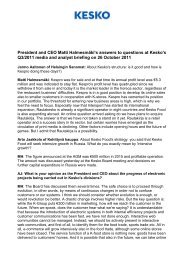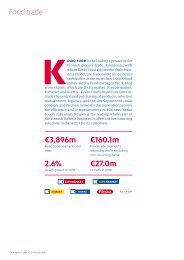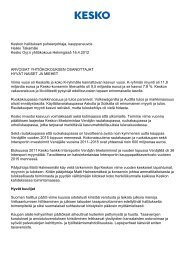You also want an ePaper? Increase the reach of your titles
YUMPU automatically turns print PDFs into web optimized ePapers that Google loves.
86 <strong>Kesko's</strong> <strong>year</strong> <strong>2007</strong><br />
ceases. When determining the existence of control, the potential voting<br />
rights that are currently exercisable have been taken into account. The<br />
main subsidiaries are listed in Note 50.<br />
Internal shareholdings are eliminated by using the acquisition cost<br />
method. The cost of acquisition is determined on the basis of the fair<br />
value of the acquired assets as on the date of acquisition, the issued<br />
equity instruments and liabilities resulting from or assumed on the date<br />
of the exchange transaction, plus the direct expenses relating to the<br />
acquisition. The identifiable assets, liabilities and contingent liabilities<br />
of the acquiree are measured at the fair value on the date of acquisition,<br />
gross of minority interest.<br />
All intra-group transactions, receivables and payables, unrealised<br />
gains and internal distribution of profits are eliminated when preparing<br />
the consolidated financial statements. Unrealised losses are not eliminated,<br />
if the loss is due to the impairment of an asset. Minority interests<br />
in the net profit are disclosed in the income statement and the amount of<br />
equity attributable to minority interest is disclosed separately in the<br />
Group's equity in the balance sheet.<br />
Associates<br />
Associates are enterprises in which the Group owns 20–50% of the voting<br />
rights, or otherwise has significant influence, but not control. Associates<br />
are consolidated by using the equity method. A share of an associate's<br />
net profit for the period corresponding to the Group’s ownership interest<br />
is disclosed separately in the consolidated financial statements. The<br />
Group's share of an associate's post-acquisition net profit is added to the<br />
acquisition cost of the associate's shares in the consolidated balance<br />
sheet. Conversely, the Group’s share of an associate's post acquisition net<br />
losses is deducted from the acquisition cost of the shares. If the Group's<br />
share of an associate's losses is in excess of the carrying amount, the<br />
part in excess is not deducted unless the Group has undertaken to fulfil<br />
the associate's obligations. Unrealised gains between the Group and<br />
associates are eliminated in proportion to the Group's ownership interest.<br />
Dividends received from associates are deducted from the Group's<br />
profit and the cost of the shares. An investment in an associate includes<br />
the goodwill generated by the acquisition. Goodwill is not amortised. The<br />
main associates are listed in Note 50.<br />
Joint ventures<br />
Joint ventures are enterprises in which the Group and another party exercise<br />
joint control by virtue of contractual arrangements. The Group's<br />
interests in joint ventures are consolidated proportionally on a line-byline<br />
basis. The consolidated financial statements disclose the Group's<br />
share of a joint venture's assets, liabilities, income and expenses. At the<br />
end of the accounting period, the Group has no joint ventures.<br />
Mutual real estate companies<br />
In compliance with IAS 31, mutual real estate companies are consolidated<br />
as assets under joint control on a line-by-line basis in proportion to<br />
ownership.<br />
Foreign currency items<br />
The consolidated financial statements are presented in euros, which is<br />
both the functional currency of the Group’s parent company and the<br />
reporting currency. On initial recognition, the figures relating to the<br />
result and financial position of Group entities located outside the euro<br />
zone are recorded in the functional currency of their operating<br />
environment.<br />
Monetary foreign currency transactions are recorded in euros by<br />
applying the exchange rate at the date of the transaction. Foreign currency<br />
receivables and liabilities are translated into euros using the closing<br />
rate. Profits and losses from foreign currency transactions and from<br />
receivables and liabilities are recognised in the income statement with<br />
the exception of those loan exchange rate movements designated to provide<br />
a hedge against foreign net investments and regarded as effective.<br />
Foreign exchange gains and losses from operating activities are included<br />
in the respective items above operating profit. Gains and losses from forward<br />
exchange contracts and options used to hedge financial transactions,<br />
and from foreign currency loans are included in financial income<br />
and expenses.<br />
The income statements of Group entities operating outside the euro<br />
zone have been translated into euros at the average rate of the reporting<br />
period, and the balance sheets at the closing rate. The translation difference<br />
resulting from the use of different rates is recognised in equity. The<br />
translation differences arising from the elimination of the acquisition<br />
cost of subsidiaries outside the euro zone, and the hedging result of net<br />
investments made in them, are recognised in equity. In connection with<br />
the disposal of a subsidiary, currency translation differences are disclosed<br />
in the income statement as part of the gains or losses on the<br />
disposal.<br />
As of 1 January 2004, the goodwill arising from the acquisition of foreign<br />
units and the fair value adjustments of assets and liabilities made<br />
upon their acquisition have been treated as assets and liabilities of these<br />
foreign units and translated into euros at the closing rate. The goodwill<br />
and fair value adjustments of acquisitions made prior to 1 January 2004<br />
have been recorded in euros.<br />
Financial assets<br />
As of 1 January 2005, the Group has applied IAS 32 Financial Instruments:<br />
Disclosure and Presentation, and IAS 39 Financial Instruments:<br />
Recognition and Measurement, as well as IFRS 7 Financial Instruments:<br />
Disclosures starting from 1 January <strong>2007</strong>.<br />
The Group classifies financial assets in the following categories: 1)<br />
financial assets at fair value through profit or loss, 2) available-for-sale<br />
financial assets, and 3) loans and receivables. The classification of financial<br />
assets is determined on the basis of why they were originally<br />
acquired. Purchases and sales of financial assets are recognised using<br />
the ‘regular way’ method. Financial assets are classified as non-current<br />
assets if they have a maturity date greater than twelve months after the<br />
balance sheet date. If financial assets are going to be held for less than 12<br />
months, they are classified as current assets. Financial assets at fair<br />
value through profit or loss are classified as current assets. Financial<br />
assets are derecognised when the contractual rights to the cash flow of<br />
the financial asset expire or have been transferred to another party, and<br />
when the risks and rewards of ownership flown from the Group.<br />
At each reporting date, the Group assesses whether there is any indication<br />
that a financial asset may be impaired. If any such indication<br />
exists, the recoverable amount of the asset is estimated. The recoverable<br />
amount is the fair value based on the market price or the present value of<br />
cash flows. An impairment loss is recognised if the carrying amount of<br />
an asset exceeds its recoverable amount. The impairment loss is disclosed<br />
in the financial expenses of the income statement, net of interest<br />
income.















